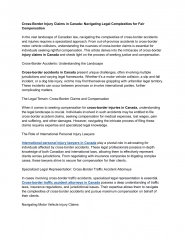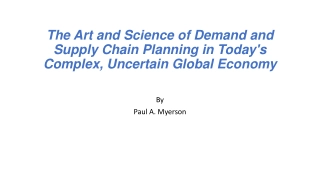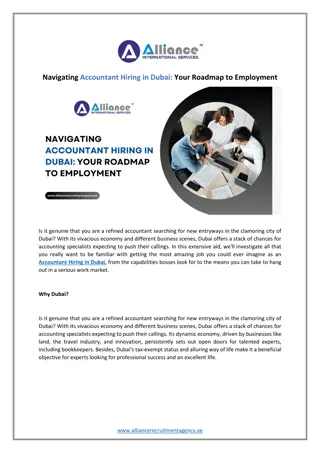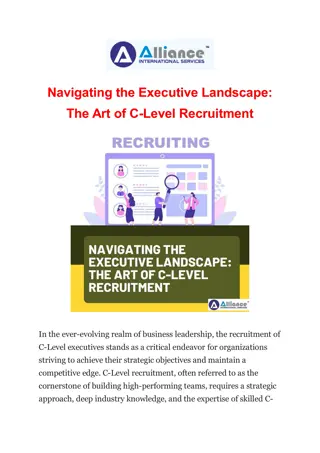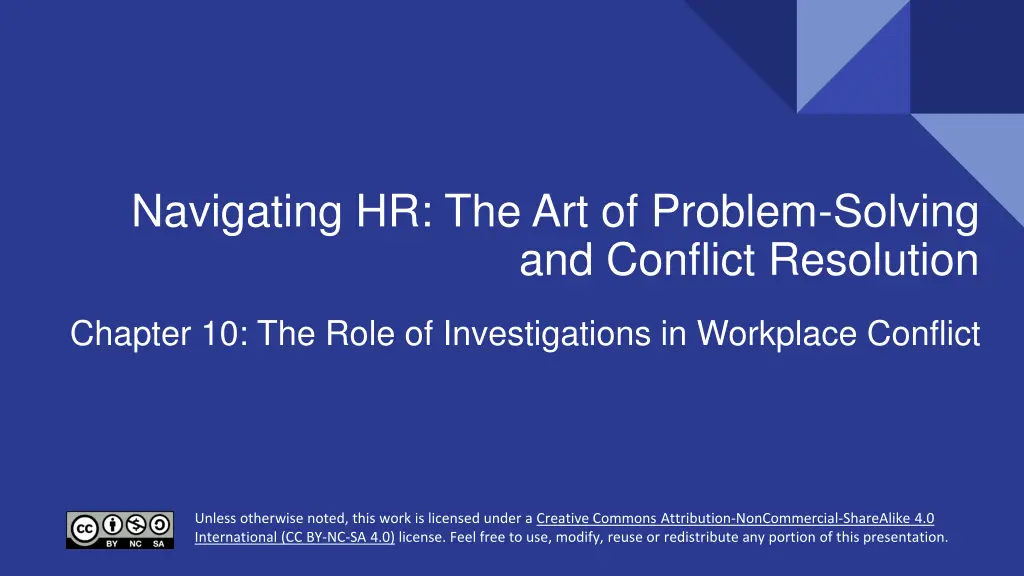
Workplace Conflict Resolution Investigations
Learn about the crucial role of investigations in resolving workplace conflicts, including the importance of addressing concerns, preparing for investigations, gathering evidence, and notifying involved parties. Understand the significance of documentation, confidentiality, employer policies, training requirements, and the types of evidence essential for a thorough workplace investigation.
Uploaded on | 1 Views
Download Presentation

Please find below an Image/Link to download the presentation.
The content on the website is provided AS IS for your information and personal use only. It may not be sold, licensed, or shared on other websites without obtaining consent from the author. If you encounter any issues during the download, it is possible that the publisher has removed the file from their server.
You are allowed to download the files provided on this website for personal or commercial use, subject to the condition that they are used lawfully. All files are the property of their respective owners.
The content on the website is provided AS IS for your information and personal use only. It may not be sold, licensed, or shared on other websites without obtaining consent from the author.
E N D
Presentation Transcript
Navigating HR: The Art of Problem-Solving and Conflict Resolution Chapter 10: The Role of Investigations in Workplace Conflict Creative Commons Attribution-NonCommercial-ShareAlike 4.0 International (CC BY-NC-SA 4.0) Creative Commons Attribution-NonCommercial-ShareAlike 4.0 International (CC BY-NC-SA 4.0) Unless otherwise noted, this work is licensed under a Creative Commons Attribution-NonCommercial-ShareAlike 4.0 International (CC BY-NC-SA 4.0) license. Feel free to use, modify, reuse or redistribute any portion of this presentation.
10.0 Learning Outcomes In this chapter, we will: Identify the role of investigations in workplace conflict resolution. Discuss the role of empowerment when assisting employees in resolving their workplace conflicts. Apply employee empowerment to a workplace scenario.
10.2 The Lesson: The Role of Investigations in a Workplace Conflict Importance of Addressing Concerns: Take all concerns seriously, document them, and maintain confidentiality. Formal Investigations: Required for harassment cases under the Occupational Health and Safety Act. Employer Policies: Policies may require investigations for issues like finances. Training Requirements: Have a trained investigator and seek legal advice for compliance. Training Programs: Examples include HRPA and Osgoode workplace investigation training. Image Image by Mimi Thian, Unsplash License Mimi Thian Unsplash License
10.2 Preparing for a Workplace Investigation Investigation Scope: Plan for either a full-scale or brief investigation, depending on the situation. Thorough Preparation: Ensure the investigation is well-prepared to support any employer actions. Objectives of the Investigation Determine what happened with respect to an incident. Determine who was involved in the incident. Determine the events surrounding the incident. Determine if there is evidence to support a claim of workplace misconduct. Determine if there was a violation of company policy and procedures, a breach of compliance or a violation of the law. Complete a thorough investigation that can withstand scrutiny. Evidence
10.2 Evidence Purpose of Evidence: Gathering quality evidence is crucial for making prudent and wise conclusions in an investigation. Key vs. Extraneous Evidence: Investigators must distinguish key evidence from irrelevant information. Definition of Evidence: Evidence is anything that helps prove or disprove a claim, as defined by Cambridge Dictionary. Workplace Evidence: The most relevant evidence is often oral testimony from involved parties or witnesses. Documentary Evidence: Includes files, records, emails, and other written materials. Physical Evidence: Can include video recordings, social media screenshots, or damaged items.
10.2 Notifications and Parties Involved Notification Process: Notify all identified participants of the investigation, adding new ones as necessary during the process. Complainant Role: The complainant is the individual or organization making the complaint, often involving harassment, discrimination, or misconduct. Respondent Role: The respondent is the individual(s) accused in the complaint, with separate investigations possible if issues are unrelated. Witness Definition: A witness is someone who sees, knows, or can vouch for relevant details related to the complaint. Complainant as Witness: When the organization is the complainant, supervisors or managers may act as witnesses to the issue. Witness Responsibilities: Witnesses may provide firsthand accounts, overheard details, or relevant expertise, such as in cases of suspected fraud.
10.2 Opening Statement and Confidentiality Preparation Reduces Anxiety: Being prepared and having a plan helps investigators manage nerves during interviews. Professional Opening: A sincere and informative opening sets a professional tone, clarifies roles, and eases interviewee concerns. Confidentiality: Investigators must limit information sharing to those directly involved, avoiding broad dissemination, and only provide final reports, not interview notes, unless required by policy or law. A standard opening to an investigation will cover the following items: Introductions Rapport Building Reviewing the Purpose of the Interviews Ground Rules Confidentiality Retaliation 1. 2. 3. 4. 5. 6.
10.2 The Interview Interview Preparation: Begin interviews after sending notifications and preparing the opening statement and questions. Face-to-Face Interviews: Preferred method for building rapport and observing body language for visual clues. Video Interviews: A good alternative using tools like Skype, Teams, or Google Meet when in- person interviews are not possible. Telephone Interviews: Used when other options are unavailable, though body language and facial cues cannot be observed. Support and Accommodations: Ensure participants can have support persons and inquire about any necessary accommodations, such as interpreters or accessible meeting rooms. Informal vs. Formal: Interviews may be formal with extensive preparation or informal, conducted shortly after an incident.
10.2 Interview Steps Standard Opening: Begin with introducing the parties, building rapport, explaining the purpose, and setting ground rules, confidentiality, and retaliation policies. 1. Housekeeping Questions: Ask simple, non-invasive questions to help the interviewee feel comfortable, such as confirming their name, job title, and tenure. 2. Investigative Questions: Ask open-ended questions to gather detailed, firsthand accounts, allowing the interviewee to speak freely and encouraging active listening. 3. Interview Closing: Ask if the interviewee has additional information or questions, thank them, provide contact information, and inform them of the review process for the interview notes. 4. Review Interview Notes: Share the notes with the interviewee, allowing them to review, make corrections, and sign off on the accuracy of the information provided. 5. Interviewee Signs Off on Notes: The interviewee signs a statement confirming the notes are an accurate account of their responses, with the option to make changes that are noted by the investigator. 6.
10.2 Interview Notes Note-Taking Methods: Investigators can use various methods, such as notepads, bound notebooks, or laptops, depending on personal preference and typing skills. Accurate Recording: Notes should capture exactly what the interviewee said, not the investigator s interpretation or opinion. Clarity: Notes must be written clearly, avoiding shorthand, abbreviations, or shortcuts that could hinder understanding. Objectivity: The investigator should not add personal impressions or opinions in the notes, such as judgments about the interviewee s credibility. Memos to File: Investigators may make personal memos about changes made by the interviewee, but these are not signed by the interviewee and remain separate from the formal notes.
10.2 Reporting Reporting Requirements: Less formal investigations may conclude with a meeting or informal email summarizing findings, while more formal investigations may require a detailed report. Findings: The investigator must make clear conclusions based on the investigation, addressing the who, what, when, where, how, and potentially why. Formal Reports: In formal investigations, a comprehensive report is typically shared with management, HR, and the union (if applicable). Content of Reports: Investigative reports summarize the investigation, detailing how it was conducted, the evidence provided, and the findings. Objective of Reports: The goal is to address whether misconduct occurred, if there was a policy violation, and ensure the investigation can withstand scrutiny.
10.3 Spotlight on Human Resources Skills Empowerment Definition: Empowerment is the process of gaining the freedom and power to control one's actions and outcomes. Empowerment in HR: HR professionals can use empowerment techniques to help employees gain confidence in addressing workplace disagreements. Workplace Disagreement Triggers: Communication styles, personalities, and work styles can lead to conflicts among employees. Self-Awareness: Helping employees understand their own emotions, thoughts, and behaviors, as well as those of their colleagues, is key to empowerment. Self-Reflection: Encouraging employees to reflect on their emotional reactions, like preferring face-to- face communication over emails, promotes self- awareness and conflict resolution. Empower Empower by Nick Youngson, CC BY-SA 3.0 Nick Youngson CC BY-SA 3.0
10.3 Empowerment at Work Empowerment: Empowerment involves giving control to others to make decisions and choose outcomes, providing them with a sense of control over their fate. Empowerment in Business: It is essential for good management, improving employee performance, productivity, and job satisfaction by providing opportunities for learning and growth. Two-Way Process: Empowerment requires both the manager to release control and the employee to seize opportunities, demonstrating initiative and taking decisions in the best interest of the organization. Modern Employee Expectations: Employees seek empowerment to make independent decisions and have more control over their roles and the organization's direction. Examples of Empowerment: John takes the initiative to discuss his career goals with his manager, empowering himself to chart his path for advancement. Sophia empowers her team by allowing them to share responsibility for hiring new developers.
10.3 Organizations Culture and Employee Empowerment Impact of Organizational Culture: A rigid, risk-averse culture can discourage employee empowerment, as employees may feel restricted in making decisions or taking risks. Supportive Culture Traits: Cultures that emphasize openness, flexibility, and acceptance encourage empowerment by energizing employees to take control of their fate and contribute to the organization's success. Manager Role Shift: In empowered organizations, managers transition from authority figures to coaches, mentors, and facilitators, helping employees grow and take charge. Employee Empowerment Benefits: Empowerment increases employee satisfaction, efficiency, and effectiveness, which leads to improved performance, productivity, and profitability for the organization. Leadership Development: Empowerment allows employees to develop leadership skills by taking on decision-making and problem-solving responsibilities. Organizational Success: Empowerment fosters creativity, efficiency, and profitability, helping businesses grow and achieve long-term success by cultivating strong leaders.
10.6 Key Takeaways It is crucial to ensure that one person in your organization is formally trained in conducting workplace investigations. As a Human Resources professional, it is essential to seek legal advice when addressing workplace conflicts to ensure legal compliance. The Occupational Health and Safety Act mandates that an organization conduct a formal workplace investigation in matters surrounding harassment. It is essential to empower employees so they are comfortable addressing disagreements at work. Common disagreements at work involve differing work styles, communication styles and personalities. Empowerment involves self-awareness of your approach to work based on your thoughts and emotions. Employees who feel empowered are more able to resolve disagreements that could lead to workplace conflicts if left unchecked.



